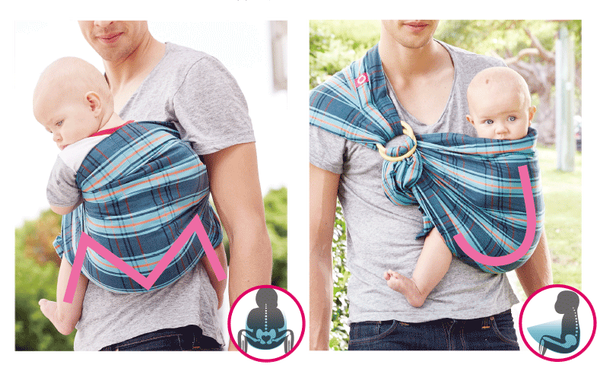Carry With Care: The History, Benefits and How To Guide For Baby Wearing
Share

We can all agree the formative years of your newborn are a melting pot of the delicate, cute, stressful, sentimental and memorable. While your newborn continues to develop their motor, cognitive, linguistic, and anatomical skills in their magical growth, they need both mommy and daddy’s support in carrying them with care. For International Babywearing Month, I was tasked with the divine duty of taking you through the history of babywearing, the benefits of babywearing, and the fundamental importance of the traditional baby sling.
The History Of Baby Wearing [As extracted from jennijenkins.com]
Historically, humans have maintained close contact with their babies as opposed to leaving them isolated in their developmental stages. A significant part of human evolution is the increased size of our brains and the skull that covers them. Thus, infant babies developed large heads to make up for our increasingly growing brain size. This increase in head size meant human babies needed to enter the world before when they were developmentally able to cling to their mothers so that they could fit through the birthing person’s birth canal.
To continue their nomadic lifestyle, early humans began babywearing to keep their little ones safe and close. This means babywearing originated from early humans, at least half a million years ago and probably earlier when they began making carriers. Baby carriers may have been one of the first early human inventions.
The Progression and Rise of Modern Babywearing
People began to craft fibres to make cloth. What started as a way to construct more secure and long-lasting baby carriers turned into an art form. Baby carriers in Asian communities saw baby carriers embellished with one-of-a-kind designs. Japanese families would utilise kimono silk. Indian ladies used saris, the Mexicans used the sacred Rebozo, and African women used kanga and kitenge fabric. In the 1970s, a nurse named Ann Moore created the soft structured carrier, the Snugli, after watching mothers babywearing in Togo.
The woven wrap company, Didymos, began creating wraps after being introduced to the Mexican Rebozo in the 1970s. Since then, several companies such as Ergo, K’tan, LÍLLÉbaby, Tula Baby, Didymos, and more have started making baby carriers of various designs and styles. In recent years, the increased use of social media has helped babywearing flourish in the mainstream parenting world. Modern parents have indigenous parents to thank for the continued practice of babywearing and the knowledge passed down through generations.
Benefits of Babywearing Case In Point: The Baby Sling [Reference: Kiddy123.Com]
As you have seen, there is a creative nuance in which you can approach babywearing to ensure your little one is all snug and tug on mommy/daddy. Interestingly enough, my research has advocated for the benefits of using a baby sling, which on the surface level includes:
- Eases the frequency of baby crying
- Promoted emotional and intellectual development
- It eases the physical strain on caregivers
- Great for travelling
- Babywearing is more compact and minimal than a stroller
- Perfect for naps
- Perfect for others to bond with the baby (the other parent, family members, older siblings, )
- Tummy time
- Communication/speech-building
- Ideal for breastfeeding
However, I couldn’t resist how pivotal a baby sling is in an infant’s structural, physiological, and neurological development. A baby’s brain development is expedited when they are moving in stable, rhythmic ways. Neuroscience studies have shown that the way the baby is carried will have a significant and lasting impact on the vestibular system.
When they are carried while moving steadily and in the same direction, it will quicken their brain development. These movements aid their nervous system development and the brain to command and maintain the balance between core muscles and intrinsic spinal muscles. In addition, it helps coordinate muscles to complete simple to complex body movements.
“Newborns’ spine looks like a big C; they perform the same curving position as when they were in the womb. As they grow their neck and back muscles start to grow stronger, enabling them to lift their head. Parents’ body curve can assist [the] baby’s back muscle development, maintaining the right position.
Baby’s first year is an important stage of the spinal cord and nervous system development. When the baby is carried correctly on the carrier’s body, through natural formed mechanical balance will benefit the baby’s spine and muscle development.”


How is Baby Sling Different from Other Carriers?
“Conventional waist stools and swaddle blankets have an apparent downward pull without supporting the baby’s thighs and knees. Baby’s legs are left dangling, affecting their hip joint development and possible joint dislocation.
When you’re carrying the baby with a sling, the baby’s position should be C-shaped (or J-shaped) when looking from the side with the knees lifted higher than the buttocks. The baby should be in M-position (jockey position) when looking from the back, the baby’s body, buttocks, thighs and knees are all supported.
According to International Hip Dysplasia Institute, the M-position can support babies’ thigh and knee-joint; the legs can stretch; the buttocks are stabilised; less pressure is endured by the hip joint, and it reduces the chances of hip joint dislocation or poor development.”
The T.I.C.K.S. Rule For Safe Babywearing
- Tight
- In view at all times
- Close enough to kiss
- Keep off the chest
- Supported back
Alas, fellow parents, the road to adorable smiles, laughter and those peaceful laughs may be paved with a fair share of frustration. May this food for thought light the way to a pleasurable experience in raising our little ones. We often forget that they are only cute and cuddly once in their lives, and then we have teenagehood to deal with!




